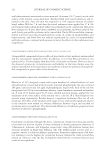INTERPRETATION OF HALAL COSMETICS IN MALAYSIA 153 ACKNOWLEDGMENTS The authors would like to thank their colleagues from the Department of Science and Technology Studies, UM, and University Malaya Halal Research Centre (UMHRC) for their assistance with the references and comments that are greatly helpful in producing this manuscript. Author contributions: F.N.M.N. helped in conceptualization, methodology, analysis, and writing and C.W.J.W.M.R. performed supervision. Funding: This work was fi nancially supported by the University of Malaya Research grant under Grand Challenge for Humanities Research Cluster (GC002C-17HNE). REFERENCES (1) Environmental Working Group, Exposures Add up – Survey Results (2016), accessed July 15, 2019, https://www.ewg.org/testimony-offi cial-correspondence/ewg-testimony-exploring-current-practices- cosmetics-development#_ftnref. (2) Mercola, Women Put an Average of 168 Chemicals on Their Bodies Daily (2015), accessed July 15, 2019, http://articles.mercola.com/sites/articles/archive/2015/05/13/toxic-chemicals. (3) P. Hashim and D. Mat Hashim, A review of cosmetic and personal care products: halal perspective and detection of ingredient, Pertanika J. Sci. Technol., 21(2), 281–292 (2013). (4) Grand View Research, Skin Care Products Market Size, Share & Trends Analysis Report, By Product (Face Cream, Body Lotion), by Region (North America, Central & South America, Europe, APAC, MEA), and Segment Forecasts, 2019–2025 (2019), Market Research Report. Report ID: 978-1-68038-902-9. accessed May 31, 2019, https://www.grandviewresearch.com/industry-analysis/skin-care-products-market. (5) M. A. Hassali and S. AL-Tamimi, Malaysian cosmetic market: current and future prospects, Pharmaceut. Reg. Affairs., 4(4), 4–6 (2015). (6) S. Ali, F. Halim, and N. B. Ahmad, Beauty premium and halal cosmetics industry, J. Market. Manag. Consumer Behav., 1(4), 52–63 (2016). (7) M. R. Haliza, Beauty or health? A personal view. Malay. Fam. Phys., 1(1), 42–44 (2006). (8) Mordor Intelligence, Halal Cosmetic Products Market - Trends, Growth, Share, Industry Analysis (2017–2022) 2017, accessed September 6, 2020, https://www.mordorintelligence.com/industry- reports/halal-cosmetic-products-market. (9) M. H. Kamali, The Parameter of Halal and Haram in Shariah and the Halal Industry, (The International Institute of Islamic Thought, London, United KIngdom, 2013) . (10) JAKIM, Manual Procedure for Malaysia Halal Certifi cation (Third Revision), Jabatan Kemajuan Islam Malaysia, Putrajaya, Malaysia (2014). (11) J. Alzeer, U. Rieder, and K. A. Hadeed, Rational and practical aspects of Halal and Tayyib in the context of food safety. Trends Food Sci. Tech., 71, 264–267 (2018). ( 12) A. Kowcz, G. Schneider, W. Pape, and T. M. Weber, “Bench to beauty counter: development of cosme- ceuticals,” in Cosmeceuticals and Cosmetic Practice, P. K. Farris. Ed. (John Wiley & Sons, West Sussex, United Kingdom, 2014). (13 ) Z. Zakaria, Regulation of cosmetics: what has Malaysia learnt from the European system? J. Consumer Policy, 38(1), 39–59 (2015). (1 4 ) C. Juliano and G. Magrini, Cosmetic ingredients as emerging pollutants of environmental and health concern, A mini-review. Cosmetics., 4(4), 11 (2017). (15 ) S. R. Zulaikha, S. N. Syed Ismail, and S. M. Praveena, Hazardous ingredients in cosmetics and personal care products and health concern: a review. Public Health Res., 5(1), 7–15 (2015). (1 6 ) Malaysian Standard MS2634, Islamic Consumer Goods Part 1: Cosmetic and Personal Care–General Guidelines (Department of Standards Malaysia, Selangor, Malaysia, 2019). (1 7 ) F. Pandagel, N. Waranuch, and P. Plianbangchang, Categorization of Cosmetic Products According to Halal Principle, Naresuan University, Thailand, 21-22 July, (2013). (18 ) Cosmetic Ingredient Review (CIR), accessed July 15, 2019, https://cosmeticsinfo.org/cir. (19 ) NPRA, Guidelines for Control of Cosmetic Products in Malaysia (NPRA, Petaling Jaya, Selangor, 2017).
JOURNAL OF COSMETIC SCIENCE 154 (2 0 ) M. Tieman, The application of halal in supply chain management: in-depth interviews. J. Islamic Mar- ket., 2(2), 186–195 (2011). (2 1 ) American Cancer Society, Cosmetics, accessed October 8, 2020, https://www.cancer.org/cancer/cancer- causes/cosmetics.html. (2014). (22 ) National Pharmaceutical Regulatory Agency (NPRA) (2019), Pembatalan Notifi kasi Produk Kosmetik, accessed July 15, 2020, https://www.npra.gov.my/index.php/en/consumers/safety-information/cancella- tion-of-notifi ed-cosmetic-products.html. (23 ) P. Hashim, N. Shahab, T. Masilamani, R. Baharom, and R. Ibrahim, A cosmetic analysis in compliance with the legislative requirements, halal and quality control. Malay. J. Chem. 11(1), 81–87 (2009). (2 4 ) C. R. Hamann, W. Boonchai, L. Wen, E. N. Sakanashi, C. Y. Chu, K. Hamann, P. Hamann, K. Sinniah, and D. Hamann, Spectrometric analysis of mercury content in 549 skin-lightening products: is mercury toxicity a hidden global health hazard? J. Am. Acad. Dermatol., 70(2), 281–287.e3 (2014). (25 ) Y. B. Ho, N. H. Abdullah, H. Hamsan, and E. S. S. Tan, Mercury contamination in facial skin lighten- ing creams and its health risks to user. Regul. Toxicol. Pharmacol., 88, 72–76 (2017). (2 6 ) I. Al-Saleh, Potential health consequences of applying mercury-containing skin-lightening creams dur- ing pregnancy and lactation periods. Int. J. Hyg Environ. Health, 219(4–5), 468–474 (2016). (2 7 ) World Health Organization, Mercury in Skin Lightening Products (Geneva, Switzerland: WHO 2019), accessed July 15, 2020, https://www.who.int/publications/i/item/WHO-CED-PHE-EPE-19.13. 2011. (28 ) R. Siti Zulaikha, S. I. Sharifah Norkhadijah, and S. M. Praveena, Hazardous ingredients in cosmetics and personal care products and health concern: a review, Public Health Research, 5(1), 7–15 (2015). (2 9 ) Adzlina, Halal certifi cation for cosmetic products, Seminar Kosmetik Halal, presented on November, 15, (Universiti Malaya Halal Research Centre & JAKIM, 2019). (3 0 ) K. Sugibayashi, E. Yusuf, H. Todo, S. Dahlizar, P. Sakdiset, F. J. Arce, and G. L. See, Halal cosmetics: a review on ingredients, production and testing methods. Cosmetics, 6(37), 1–17 (2019).
Purchased for the exclusive use of nofirst nolast (unknown) From: SCC Media Library & Resource Center (library.scconline.org)

























































































































